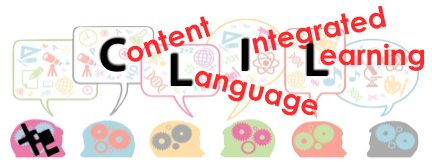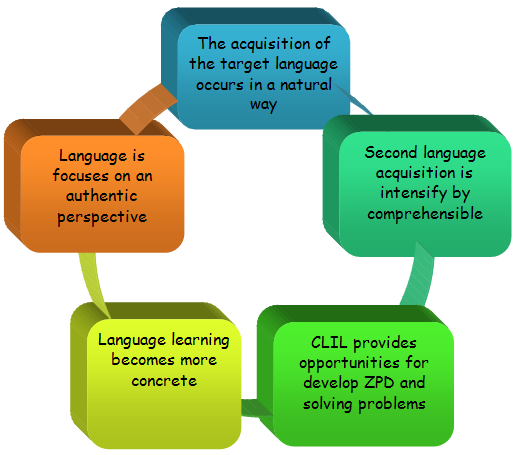CLIL - Content and Language Integrated Learning.
First of all, we would like to start by defining the concept of CLIL (Content and Language Integrated Learning - coined in Europe in the early nineties (Coyle et al (2010)), and those concepts and key aspects around this approach. Many of which will need to be considered when designing activities for the CLIL classroom that will not help our students develop and improve their communicative and foreign language skills, but their learning process.
Why CLIL?
The 21st Century educational landscape has undergone important innovations in the last decades, one of them is the introduction of technologies in the classroom and the other notable change is related to the teaching of languages being part of a connected and globalized world, it should be one objective that everyone in the world can talk other languages in addition to the mother tongue. This method started in Europe, due to the great language and cultural diversity of the country members of the European Union.
These two aspects, the introduction of ICT and the learning of languages are well reflected in the White Paper on Education and Training: Teaching and Learning - Towards the Learning Society published in 1995 by the Commission of the European Community and in later publications1 where Action Plans to promote language learning and the use of Open Educational Resources (OER) are established. Both points are among the priorities for the member states in the document published in 2012 Rethinking Education: Investing in skills for better socio-economic outcomes where the priorities are "To increase the supply of transversal skills that increase employability, such as Entrepreneurship, digital skills and languages "and" Intensify the use of ICT-assisted learning and access to high quality OER "(p.17).
I would like to highlight this excerpt from the “White Paper on Education and Training”:
“Building skills for the 21st century
Transversal and basic skills
Efforts need to be concentrated on developing transversal skills… Modern, knowledge-based economies require people with higher and more relevant skills. CEDEFOP forecasts predict that the proportion of jobs in the EU requiring tertiary level qualifications will increase from 29% in 2010 to 34% in 2020, while the proportion of low skilled jobs will fall in the same period from 23% to 18%. Transversal skills such as the ability to think critically, take initiative, problem solve and work collaboratively will prepare individuals for today's varied and unpredictable career paths. …particularly entrepreneurial skills…”
This is not happening only in Europe, but worldwide. And I would like to add something more than preparing future workers or employees as it is said, since from my point of view the socio-emotional aspects of students are empty in this document, and nowadays many researchers have proved the importance of those aspects.
Learning is a beautiful part of our lives, since it opens our eyes to new landscapes and windows that go beyond our native communities. Learning lets us go beyond, above all, foreign language acquisition and Information and Communication Technology (ICT) since the current conditions of living are globalized and it is our duty to prepare good citizens equipped with a lot of skills and tools to live in this globalized world. Opportunities can be given in any point of the world and we should be ready to get them, regardless the nationality or other bureaucratic issues. I am talking from my own experience: a Spanish teacher who has educational experience in many countries besides of my home country, Spain. Nowadays I’m teaching in Houston, Texas (USA).
Multilingual programs
In this context, a great number of bilingual programs have been implemented over the last decade, many of which use the AICLE approach in Spanish: Integración de Contenidos y Lengua Extranjera; EMILE in French: Enseignement De Matières Par Integration D'une Langue Étrangère or CLIL in English: Content Language Integrated Learning. This method can be used with any language in the world.
D. Coyle et al. (2010) distinguish two main reasons for the interest in CLIL within a country or region. One of them is a proactive reason, as a way to promote the learning of a language for political, economic and social reasons. This is the case of the French immersion programs of Canada, as a way of supporting bilingualism, or the CLIL programs that promotes the policy of the European Union to strengthen relations and mobility between the countries of the same. The European Union has essentially become a territory without borders, where all citizens have the right to live, study or work where they wish; However, not knowing languages still represents an invisible barrier to free movement that needs to be eliminated and bilingual programs are one of the most effective measures.
From a pedagogical point of view there are many reasons why bilingual and CLIL programs are recommended:
From a pedagogical point of view there are many reasons why bilingual and CLIL programs are recommended:
First, they offer advantages for students' cognitive development (Bialystock, 2009).
They bring significant gains in the target language (L2) as evidenced by numerous studies on language immersion in Canada and CLIL in Europe.
They favor the collaboration of teachers with each other and with the administration of the center since much of the community will be involved in learning the language and content.
He observes how in the following video Hugo Baetens, referring in bilingualism and CLIL of the Vrij Universiteit Brussel (VUB) alludes to the expressed in the previous point.
This is one of my first activities to plan a CLIL unit with sports:
To know more:
EU Policy Documents
EU Languages and Language policy
The White Paper on Education and Training: Access to the document in its entirety. Available for download.
Languages in education: support page for language learning and linguistic diversity of the European Commission.
See the Eurydice Report (2006) a study on how and where CLIL was being implemented in the European Union.
Coyle, D., Hood, P. and Marsh, D. 2010, CLIL. Content and Language Integrated Learning. Cambridge: Cambridge University Press.

Usos de recursos educativos abiertos para AICLE by Aprende Intef cursos en linea is licensed under a Creative Commons Reconocimiento-NoComercial-CompartirIgual 4.0 Internacional License.
Creado a partir de la obra en http://formacion.educalab.es.
Puede hallar permisos más allá de los concedidos con esta licencia en http://formacion.educalab.es



No comments:
Post a Comment